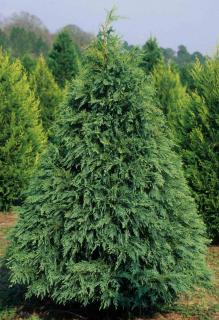

The Leyland cypress is certainly one of the conifers most used to set up a hedge.
A List of Leyland Cypress facts
Name – Cuprocyparis leylandii
Family – Cupressaceae
Type – conifer, evergreen hedge
Height – up to 65 feet (20 meters)
Exposure – full sun to shade
Soil – ordinary, well drained
Foliage – evergreen
With its extremely rapid growth, it will quickly hide you from peeking neighbors, and from strong winds, too, if you need.
Leyland cypress is usually planted as part of a hedge, and is usually set up from the beginning of fall, but it can also be planted until the month of March-April as long as it doesn’t freeze.
After planting, you can also mulch the foot of the tree in order to avoid having weeds crowd it out from below but also to protect the roots from the cold.
If you cypress is never pruned, it can grow to reach nearly 65 feet (20 meters) and its bearing will be a distinctive cone.
For hedges, select the pruning height you are comfortable with as well as the thickness.
A heavy pruning end of August is enough to keep this growth under control.
That is also the season where sap descends and so it will slow the cypress’s growth a bit.
Spring pruning is usually with rising sap and tends to accelerate the tree’s growth, so this is ideal if you aim to hide yourself from prying neighbor’s view.

Ideally, apply the following three times within the year, at the beginning and end of Spring and then once more in Fall. Of course, when planting the hedge, feel free to add these fertilizers to the soil as you backfill.
Sometimes, though, the issue isn’t a lack of nutrients: it’s a wrong pH level. If the soil is too acidic (very low pH, as in 5 or lower) or too basic (8 and higher), the cypress has trouble extracting the nutrients. For this cypress, the pH level should hover around 6.
Cypress are excellent wind-breakers ready to resist gales of any power.
They are also very resilient in the face of disease and pollution.
From an aesthetic point of view, it doesn’t have any other advantage than the deep green that lasts all year round and a high opaqueness.
Also, know that if the climate is hot in summer, Leyland cypress might not be your best candidate because it requires water in summer.
Almost all the Leyland cypress varieties found today arose from cross-pollination of two different conifers. These are the Monterey cypress and the Nootka cypress. They were planted on the Leyland estates and, in 1888, a first hybrid appeared.
Although a few specimens are over 50 years old, in hedges the trees don’t grow as old. Where soil is loose and the hedge has proper spacing, you might expect a hedge to survive up to 20 or even 30 years. However, alongside construction or roads, it might be that the hedge needs replacing even after only 10 or 15 years have gone by.
Read also:
In a hedge, think well about how high you want it to grow so that you can determine the planting distance of your Leyland cypresses accordingly! Keep a spacing of about 32 inches (80 cm) to 3 feet (1 meter) for the usual 6-foot (1.80 m) hedge.
What about fertilization of Cypress leylandii?
Hi! It’s best to fertilize at three periods of the year: beginning and end of Spring, and then Autumn. Bone meal is excellent, and nettle tea (the fermented type) is perfect.